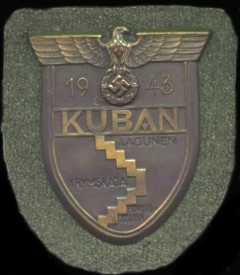
By Sebastián Bianchi
The Kuban Shield was instituted on the 21st of September 1943, to honor those who were fighting to preserve the bridgeheads in the Kuban region.
Shield Properties
The design of the badge was similar to the Krim shield, in that an eagle with outstretched wings constituted the top of the award and the bottom took a semicircular shape. The eagle clutched in its claws a wreath that surrounded a swastika, on the flanks of which were the numbers “19” and “43”. Immediately below, the word “KUBAN” was written out on block letters surrounded by two vertical lines, the top one of which was almost touching the wreath. The body of the award features a representative map of the Kuban area, with a broad jagged line representing the defensive line that the men fought to preserve. The names of bridgeheads that had been witness to particular gruesome struggles between the opposing armies are denoted in the map. These are “KRYMSKAJA” (middle of the shield), “LAGUNEN” (near the top), and “NOWORO; SSIJSK” (bottom). |
|
The shield was struck in sheet metal or zinc and treated
with a bronzed wash. A back plate, which held in place a piece of cloth
matching the recipients’ branch of service, was applied to the shield.
There were several ways to attach this plate, with again the most popular
method being the four prongs, two on top and two directly at the bottom.
The Kuban Bridgeheads
Following the encirclement and defeat of Sixth Army at Stalingrad in February of 1943, a powerful Soviet offensive threaten to encircle most of Army Group A (which was in the Caucasus) and part of Army Group Don (which had earlier attempted to relieve 6th Army). A bitter struggle ensued, with the Soviets throwing wave after wave of attacking men at the German forces in the area, forcing them out of the Caucasus and back toward the Kuban area and the city of Rostov. Incidentally, the fact that 6th Army resisted beyond the point where a breakout was possible enabled this withdrawal, and saved the Wehrmacht from certain disaster.
Hitler insisted from the start of the withdrawal on defending the Kuban bridgeheads, which he considered essential not only as an escape route, but also as a prerequisite to launching future offensives into the Caucasus. A resistance line was therefore formed between the Sea of Azov and the port of Noworossijisk, and the area was defended with desperate resolve as unit after unit withdrew toward the relative safety of the Crimea.
Soviet pressure continued during the spring and summer of 1943, even if it was at times lighter due to the need for troops in other sectors of the front. The men of 17th Army, led by General Ruoff and under Field Marshall von Kleist’s Army Group A, held on to the bridgeheads at all costs. This heroic struggle not only allowed units to evacuate during the Soviet offensive, but also tied up important resources for the months that followed.
Eventually the success of the Soviets in other sections of the front and the toll that the North Caucasian Army was taking on the German troops led to the order to evacuate all German and Rumanian personnel. This was issued on the 4th of September, and the withdrawal took place through the straights of Kerch into the Crimea. On October 9th, 1943, the Kuban fell to the Soviets.
Hitler and the high command recognized the tenacity of the troops, and announced the Kuban shield with the following proclamation,
"To commemorate the heroic battle in the Kuban bridgehead I institute the Kuban Shield. The Kuban Shield is to be worn on the left sleeve of the uniform. The Kuban Shield is awarded as a battle badge to all members of the armed forces and those under command of the Wehrmacht who, since 1 February 1943, were honorably engaged in the battle for the Kuban bridgehead on land, in the air or at sea. The awards will be made in the name of Generalfeldmarshall von Kleist. The recipient will also receive a certificate of possession. Implementation of the award is through the high command of the Armed Forces.
Fuhrer Headquaters, 20 September 1943.
Adolf Hitler"
Award Criteria
As mentioned in its institution order, the shield was presented to those who defended the bridgeheads from February 1943 until they were abandoned in October. The criteria for Heer and auxiliary forces was as follows,
-To have served in the bridgehead for 60 days.
-To have been wounded while serving on the bridgehead.
-To have been engaged in one major operation at the bridgehead.
Luftwaffe and Kriegsmarine personnel were awarded the shield based on a fairly complicated point system.
Each recipient was entitled to five copies of the award, and more could be purchased, if needed, through the appropriate LDO outlet by producing the certificate of entitlement. In case of death, a single shield was presented to the next of kin along with a possession certificate.
![]()
© Copyright Wehrmacht-Awards.com LLC |
